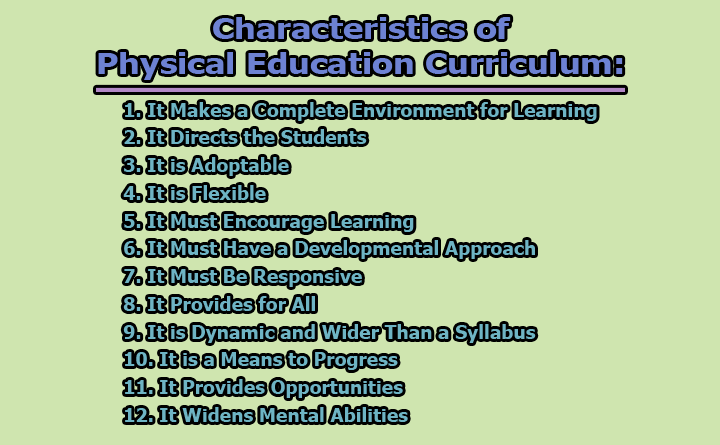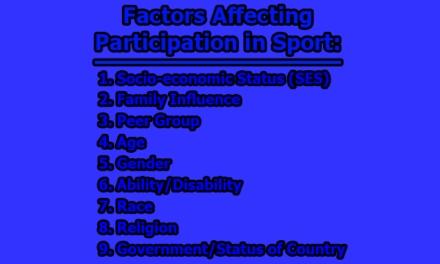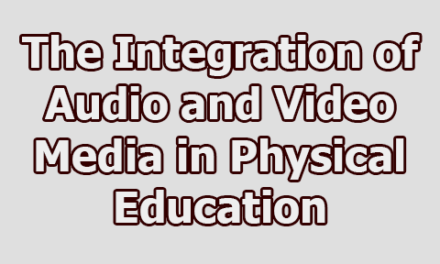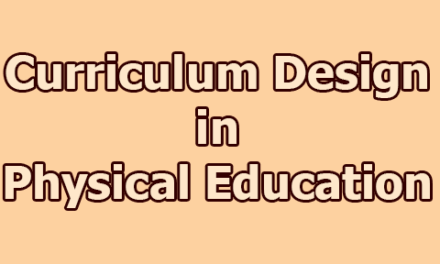Characteristics of Physical Education Curriculum:
Physical education is an integral component of a well-rounded education system, contributing significantly to the holistic development of students. The curriculum designed for physical education plays a crucial role in shaping the learning environment and guiding students towards a meaningful and purposeful understanding of physical activity. This article delves into the key characteristics of physical education curriculum, emphasizing its adaptability, flexibility, and responsiveness to the diverse needs of students and communities.
1. It Makes a Complete Environment for Learning: A comprehensive physical education curriculum goes beyond the mere provision of exercise routines; it establishes a holistic learning environment. This encompasses various facets, including teaching methodologies, the resources allocated for learning, assessment systems, the overall school ethos, and the interpersonal dynamics among students and staff. The intention is to create a rich tapestry of experiences from which students can learn and grow.
In this environment, teaching methods are not confined to traditional approaches but are tailored to engage students effectively. Resources extend beyond sports equipment, including technology and interactive learning materials that cater to diverse learning styles. The assessment systems are designed not only to measure physical abilities but also to gauge cognitive understanding, fostering a well-rounded evaluation of student progress. The school ethos, shaped by the physical education curriculum, emphasizes the importance of health, teamwork, and personal development, creating a positive atmosphere for learning.
The interactions among students and staff are crucial components. Respectful behavior, teamwork, and a supportive atmosphere contribute significantly to the learning experience. By integrating all these elements, the curriculum aims to provide students with a comprehensive and immersive education in physical well-being.
2. It Directs the Students: A well-structured physical education curriculum serves as a guiding compass for students, infusing their lives with meaning, purpose, and enjoyment. This direction is achieved through careful alignment and coherence among the various dimensions of the curriculum. Each component, whether it be lesson plans, extracurricular activities, or assessment methods, is purposefully integrated to contribute to the overarching educational goals.
Meaning is instilled by emphasizing the relevance of physical activity to overall well-being and personal development. Purpose is introduced by setting clear objectives for skill acquisition, fitness improvement, and fostering a positive attitude towards an active lifestyle. Enjoyment is woven into the fabric of the curriculum through engaging and varied activities that make physical education a source of pleasure and motivation.
The curriculum, in essence, is a roadmap that not only guides students through the realms of physical fitness but also instills values, life skills, and a positive mindset. By providing a clear direction, it ensures that students derive enduring meaning and purpose from their engagement with physical education.
3. It is Adoptable: Recognizing the diversity among schools and communities, a successful physical education curriculum must be adaptable. It should have the capacity to cater to the particular needs, resources, and cultural contexts of different educational settings. This adaptability ensures that the curriculum remains relevant and meaningful, fostering a sense of inclusivity.
Adaptability in the curriculum allows educators to tailor their approach to the unique characteristics of each school and community. It considers factors such as available facilities, community interests, and local traditions. By adopting a flexible mindset, the curriculum becomes a tool that can be molded to fit various educational landscapes while retaining its core principles.
This adaptability also extends to changes in educational trends and advancements in the field of physical education. A curriculum that can evolve with the times ensures that students receive a contemporary and dynamic learning experience, preparing them for the challenges of the modern world.
4. It is Flexible: Flexibility is a hallmark of a modern physical education curriculum, acknowledging the need for innovation and responsiveness to the evolving educational landscape. The framework should strike a delicate balance between universal principles of education and the adaptability required for the twenty-first century.
In practice, flexibility means the ability to integrate new teaching methodologies, emerging technologies, and innovative approaches to physical activity. It empowers educators to tailor their strategies to the unique needs of their students and communities. This flexibility not only enhances the effectiveness of the curriculum but also encourages a culture of continuous improvement.
The curriculum’s flexibility extends to accommodating diverse learning styles and preferences among students. Recognizing that individuals learn at different rates and through various methods, the curriculum should provide options and alternatives, ensuring that each student can engage with the material in a way that suits their needs.
5. It Must Encourage Learning: A dynamic physical education curriculum must go beyond the conventional understanding of learning, embracing new technologies as tools for educational enhancement. By incorporating cutting-edge technology into the learning process, the curriculum encourages students to explore and engage with physical activities in innovative ways.
Modern tools, such as virtual reality simulations, interactive apps, and data-tracking devices, provide avenues for a more immersive and personalized learning experience. These technologies not only make learning more engaging but also foster the development of digital literacy skills – a crucial aspect in the twenty-first century.
Encouraging learning in the context of physical education also means creating an environment where curiosity and exploration are valued. The curriculum should stimulate critical thinking about the role of physical activity in overall well-being, enabling students to make informed decisions about their health and lifestyle choices.
Consequently, the encouragement of learning within the physical education curriculum involves leveraging technology, fostering curiosity, and creating an environment where students actively participate in the learning process, contributing to their overall development.
6. It Must Have a Developmental Approach: Students embark on their educational journey with varying rates of development and diverse learning styles. A successful physical education curriculum recognizes and accommodates these differences through a developmental approach. This approach acknowledges that students construct new knowledge and understanding in ways that link their learning to their previous experiences.
In practical terms, the curriculum should offer a progression of skills and activities that align with students’ cognitive and physical development. It should cater to different learning paces, allowing each student to advance at their own rate. By adopting a developmental approach, the curriculum becomes a tool for personalized growth, ensuring that students build on their existing knowledge while being challenged to reach new levels of proficiency.
The curriculum’s developmental perspective extends beyond physical skills to encompass the holistic development of students. It recognizes the importance of instilling values, fostering social skills, and promoting a positive attitude towards physical activity as integral components of a student’s overall growth.
7. It Must Be Responsive: A responsive physical education curriculum anticipates and addresses the changing landscape of society, technology, and education. It acknowledges that societal and technological changes impact students’ needs, and the curriculum must evolve to meet these emerging requirements.
Responsive curricula embrace emerging trends in physical activity, health, and well-being. This may involve integrating new sports, activities, or health-related topics that align with contemporary issues. For example, adapting to technological changes might involve incorporating digital fitness tracking or utilizing online resources to enhance learning experiences.
Furthermore, a responsive curriculum is attuned to the diverse needs and backgrounds of students. It takes into account the evolving demographic makeup of the student population and seeks to create an inclusive environment that respects and values diversity.
By being responsive, the curriculum ensures that students are equipped with the knowledge and skills needed to navigate a rapidly changing world, promoting adaptability and resilience.
8. It Provides for All: Inclusivity is a cornerstone of an effective physical education curriculum. It goes beyond providing equal access to all students; it recognizes and values the diverse starting points, learning rates, and previous experiences of individual students.
The curriculum should be designed to cater to students of different abilities, ensuring that all groups, irrespective of educational setting, have access to a wide and empowering range of knowledge, skills, and values. This inclusivity extends to considerations of gender, cultural background, and socioeconomic status, fostering an environment where every student feels represented and valued.
Accommodating different starting points and learning rates involves providing modifications and adaptations to activities, ensuring that each student can participate and progress at a pace that suits their individual needs. In doing so, the curriculum becomes a tool for promoting equity and fostering a sense of belonging for all students.
9. It is Dynamic and Wider Than a Syllabus: While a syllabus typically outlines the specific content to be taught, a dynamic physical education curriculum goes beyond these confines. It encompasses the entire spectrum of learning experiences provided for the student, recognizing that education is a multifaceted process that extends beyond a rigid set of topics.
A dynamic curriculum embraces a variety of teaching methods, learning activities, and assessment strategies. It recognizes that students have different learning styles and preferences, and it provides opportunities for exploration and experimentation. This dynamism ensures that the curriculum remains relevant and engaging, promoting a love for physical activity that extends beyond the classroom.
The curriculum’s dynamism also allows for the incorporation of new research findings, emerging trends, and innovative practices in the field of physical education. By staying abreast of developments, the curriculum remains a dynamic and evolving tool that enriches the educational experience for students.
10. It is a Means to Progress: A well-structured physical education curriculum serves as a roadmap, providing students and their parents with a clear sense of the direction of their learning. Through appropriate assessment and reporting procedures, the curriculum offers insights into how students are progressing, both in terms of their physical skills and their overall understanding of health and well-being.
The curriculum’s role in tracking progress involves setting clear learning objectives and standards. Assessment methods should be designed not only to measure achievement but also to provide constructive feedback that guides students in their continuous improvement. Regular communication with parents ensures that they are informed about their child’s development and can actively participate in supporting their educational journey.
Subsequently, the curriculum becomes a means to measure, celebrate, and enhance students’ progress in physical education, fostering a sense of achievement and motivation to continue on their path of lifelong well-being.
11. It Provides Opportunities: A robust physical education curriculum creates opportunities for students to critically evaluate concepts such as culture, disability, race, class, and gender within the context of physical activity. By incorporating discussions and activities that explore these constructs, students develop a nuanced understanding of how societal factors influence perceptions and experiences related to sports and fitness. This fosters not only physical competence but also social awareness, promoting a more inclusive and empathetic learning environment.
Opportunities for evaluation encourage students to question stereotypes, challenge biases, and appreciate diversity in physical activities. This aspect of the curriculum prepares them to navigate a world where inclusivity and understanding of diverse perspectives are essential skills.
12. It Widens Mental Abilities: Effective physical education widens students’ mental abilities by encouraging them to make connections between ideas, people, and events. The curriculum should facilitate a holistic approach to knowledge, helping students relate local, national, and global events and phenomena to their physical education experiences.
Through interdisciplinary connections, students learn to see various forms of knowledge as interrelated and forming part of a larger whole. This widens their mental capacities, promoting critical thinking and analytical skills. By understanding the interconnectedness of knowledge, students gain a more comprehensive and meaningful perspective on the world, enhancing their cognitive abilities beyond the scope of physical activity.
In conclusion, a well-designed physical education curriculum is instrumental in shaping the future of students. By embracing adaptability, flexibility, and inclusivity, it becomes a powerful tool for fostering holistic development, responding to societal changes, and preparing students for a dynamic and interconnected world. Educators and policymakers must continue to refine and enhance physical education curricula to ensure they meet the evolving needs of students and contribute meaningfully to their overall education.

Former Student at Rajshahi University










